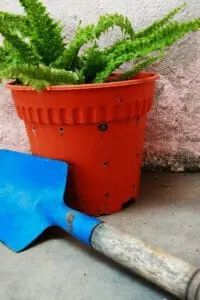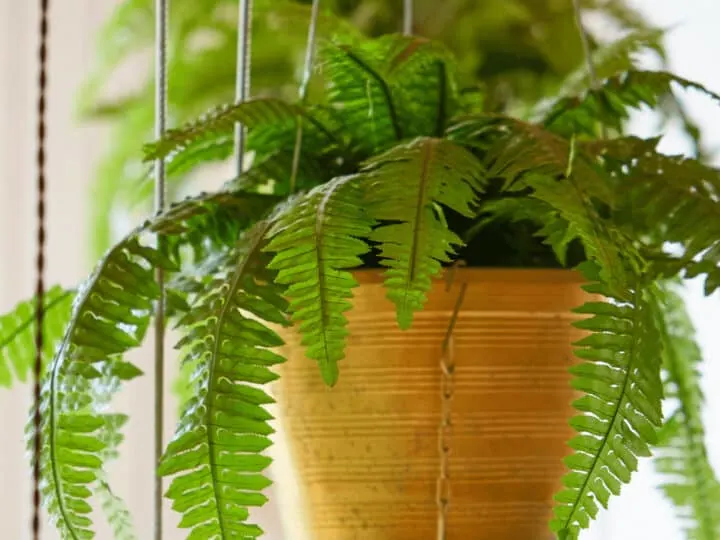The correct botanical name is N. exaltata ‘Bostoniensis’ and the variant was discovered in 1894 when a big shipment of these ferns was sent from Philadelphia to Boston according to the University of Philadelpia states.
It is the grown fern in the US according to the University of Florida.
Nephrolepis consists of around 30 different species.
These ferns are commonly found in tropical regions around the world.
There are Boston ferns that reach a height of 59 inches (1.5m) under ideal conditions.
In this article, I will talk about my Boston fern care regime and what works for me.
Boston Fern Care
To care for a Boston fern provide bright indirect light and humidity above 50%. Keep the soil slightly moist throughout the seasons except for winter, where you can let the soil dry before watering. The ideal temperature is 60-79°F (16-26°C). Fertilize using a balanced fertilizer with an NPK of 10-10-10 or 20-20-20 once a month in spring and summer.

Table of Contents
Boston Fern Care Guide
Boston Ferns grow well indoors under the right conditions, which are difficult to meet.
Ferns, in general, can be finicky to care for indoors.
But let’s get started and look at how I care for my Nephrolepis Exaltata.

Soil
For a Boston fern use a soil that is porous and organic by using a mix of compost, peat, perlite, and pine bark.
The peat will help significantly in improving water retention in the soil.
The soil also needs to be well-drained.
Water should not stagnate.
Most varieties of Nephrolepis Exaltata prefer acidic soils, though there are a few that do grow well in alkaline soils.

Light
A Boston fern grows best in brigh indirect light but will tolerate a couple of hours of direct sunlight.
However hars direct sunlight for too long will harm the plant.
3-4 hours of direct sunlight in the morning is ok.
While east and west (in a pinch) are okay, you must avoid the south-facing window.
This is because the south-facing window always has full sunshine, and ferns do not like harsh and full sunlight for extended periods.
But I would suggest choosing a north-facing window, if possible.

Watering
Keep the soil slightly moist during all seasons except winter for a Boston fern and water just before the soil becomes dry.
We should bear in mind that all types of ferns are sensitive to watering, and Nephrolepis Exaltata is no exception.
During winter, you must be careful. You should water only when the soil surface is dry.
While moisture is great, you must ensure you do not overdo it.
Excess water could lead to complete saturation, and the soil becomes soggy.
Rainwater, reverse osmosis water or distilled water would be the best options for a Nephrolepis Exaltata.
But tap water will do as well.
Be sure that the water temperature stabilizes and reaches room temperature before waterin.
Very cold water could result in a shock to the roots and could damage the fern and stunt its growth.

Temperature
Boston Fern plants love warm to average temperatures during the day with a temperature between 60-79°F (16-26°C).
They also like a gradual decrease in temperature at night.
It will undoubtedly work wonderfully well on the foliage if you can maintain this balance.
In no case should the temperature get lower than 50°F (10°C).
Humidity
Like most fern plants, Boston fern also requires high humidity levels of 50% or higher.
The optimal humidity level is even much higher.
80% or more would be preferred for the best possible conditions.
Your Nephrolepis Exaltata would thank you with stunning growth.
But let’s face it. Anything more than 50% will be hard to accomplish in most hosueholds.
They do love moist air quite a bit.
But Nephrolepis Exaltata can also be grown under average humidity levels.
However, if the humidity becomes low, the plant will suffer, and it might wither away.
It is advisable to keep the plant away from radiators and hot air vents.
This is because these devices are designed to dry out the external air considerably, and it could damage your favorite Nephrolepis Exaltata.
It is often considered to be a good plant for the bathroom. However, the bathroom should have bright natural light.
It would not be a bad idea to mist the leaves regularly or find other innovative ways to increase humidity.

Fertilizer
Fertilize a Boston fern using a balanced fertilizer with an NPK of 10-10-10 or 20-20-20 once a month in the growing season.
Nephrolepis Exaltata requires fertilizer that is complete but light.
It should have the right balance of phosphorus, nitrogen, and potassium.
Either use a water-soluble liquid fertilizer or a slow-release fertilizer in the form of granules.
Tablets or sticks could also be used.
Water-soluble fertilizers are preferred from my point of view.
This is because they are easy to dilute, and they reduce the risk of burning the fern.
Propagation
Propagate a Boston fern using fern runners or by division.
You can remove the stolons or fern runners from a mature plant.
This can be done by taking the offset of those runners that have formed roots and where they are in contact with the soil.
This helps to create a new and separate plant.

Growth
Boston fern typically grows up to 35 inches (89cm).
In optimal conditions they can even grow up to a height of 49 inches (125cm).
Potting
Repot a Boston fern once the roots have filled up the existing pot.
When repotting, be sure that the same soil level is maintained when the plant was first set in the pot.
Be careful not to bury the crown because this will lead to what is known as rotting of the crown.
Repotting is important because within a year or two, these ferns will become too big for the containers in which they are initially grown.
Add peat moss to the soil during repotting so the fern can expand.
Watering A Boston Fern The Right Way
Though water is extremely vital for Boston Fern, be careful not to overwater it.
The same applies for under-watering.
Keep the soil slightly moist but never soggy.
And except for winter, never let the soil of the Nephrolepis Exaltata become completely dry.
During summer, it might mean watering twice a week or even once daily when the weather is scorching and dry.
How Should I Water Boston Fern?
Ensure that the Boston fern plant is watered thoroughly.
The water should be at room temperature.
Never use cold water because it will cause what is referred to as root shock and could lead to root rotting.
Boston Fern Propagation
Dividing the roots is perhaps one of the most critical factors when propagating Boston ferns.
Here are a few tips that will help you with this process:
Step 1:
The process starts with separating root ball of the fern. The divided parts must be planted in new pots.
Step 2:
Pressure might be required to remove roots. Large-sized ferns could get stuck to the plant container, especially the roots.
Do not worry about exerting some pressure to remove and cut roots. These plants are designed to take harsh treatment.
Step 3:
The root ball should be cut into quarters. Ensure that the roots are spread before the actual cutting.
Also, ensure that each quarter apart from roots has an adequate number of healthy leaves.
Step 4:
Be sure that the roots of each plant are properly misted with water before potting is done.
Step 5:
Use porous, loose, and clean potting soil. The soil should be moist uniformly and should crumble to the touch.
Finally, ensure that the plant is divided regularly.
Signs That Your Boston Fern Is Sick
While some problems related to Boston Fern might be human-made, others are caused by the weather or pests.
In this section I will have a look at some of the most common signs that your Nephrolepis Exaltata is at risk.
Problem: The Leaves Are Discolored
This could be either because of improper watering or exposure to too much bright and harsh sunlight.
Discoloration might also be caused by pests and over-usage or wrong usage of fertilizers.
Identifying the root cause of discoloration and taking corrective steps immediately is advised.
If the leaf discoloration on your Nephrolepis Exaltata is caused by overwatering and the soil is still moist, you must take the plant out of the pot, rinse the roots and replace the soil and container.
Problem: Plant Looks Sick Because Of Diseases
You might come across the fronds of the fern plant turning gray.
Pythium root rot could be the cause of such discoloration. It could lead to the fronds becoming stunted or withering away.
If the roots are stunted and brown, you can be reasonably sure that the plant is suffering from root rot.
The solution to this problem is being proactive rather than reactive.
You might need a fungicide to address the problem caused by Pythium roots.
When using chemicals for treating the problem, be sure that the soil also is treated.
Problem: Fronds Turning Black
While fronds of the fern plant turning black are not always abnormal, you must be alert.
If you find that there is large-scale browning or blackening of fronds, there might be a problem with your plant.
There can be many reasons for this to happen.
But in most cases, nematodes in the soil are considered to be the culprits.
This condition can be treated by adding generous quantities of compost to the soil.
This will help in the growth of friendly fungi that can destroy the nematodes.
If the infestation is quite bad, it would be a good idea to remove the badly infected plants.
Toxicity
The Boston fern is non-toxic to animals and humans. These are pet-friendly plants that can be placed in the vicinity of cats and dogs.
Frequently Asked Questions
What should I do if the soil of my Boston fern is too alkaline?
If the soil of your Boston fern is too alkaline, adding organic mulch will help increase acidity over time. You also could add crushed limestone and oyster. This could also assist in turning the soil into acidic, but again, it will require patience and perseverance.
How To Care For a Boston Fern Outdoor?
To care for a Boston fern outdoors, ensure the soil is loosened regularly using a garden fork. Check the water regularly and water whenever you find the top layer becoming dry.
What Are The Health Benefits Of Boston Ferns?
Boston ferns, one of the oldest plants on earth, have fantastic health benefits. They help in removing pollutants from the atmosphere. They are known to remove formaldehyde from the air effectively. Removal of formaldehyde increases humidity, and it could go a long way in making the air fresh and pure.It also could help in removing xylene and toluene.
Are Boston Ferns Suitable For The Bathroom?
Boston ferns can grow well in the bathroom because of the increased humidity as long as there is enough light. In addition, a bathroom does not get uncomfortably cold in most cases, which is beneficial for growing a Boston fern.
How Do You Take Care For A Boston Fern In A Hanging Basket?
The basket or pot should be carefully placed in a location with adequate sunlight and brightness. At the same time, care should be taken to avoid too harsh sunlight. A damp spot should be chosen because this fern likes humidity more than anything else.
Conclusion
As long as you make sure the soil does not dry out completel in spring and summer and that you provide ample humidity and bright indirect sunlight, this fern most definitely will grow great in your home.
Ferns have existed for thousands of years and are great way to add more green to a peronsal space.
I enjoy caring for my Boston fern, although they can sometimes be challenging to grow.

Daniel has been a plant enthusiast for over 20 years. He owns hundreds of houseplants and prepares for the chili growing seasons yearly with great anticipation. His favorite plants are plant species in the Araceae family, such as Monstera, Philodendron, and Anthurium. He also loves gardening and is growing hot peppers, tomatoes, and many more vegetables.


